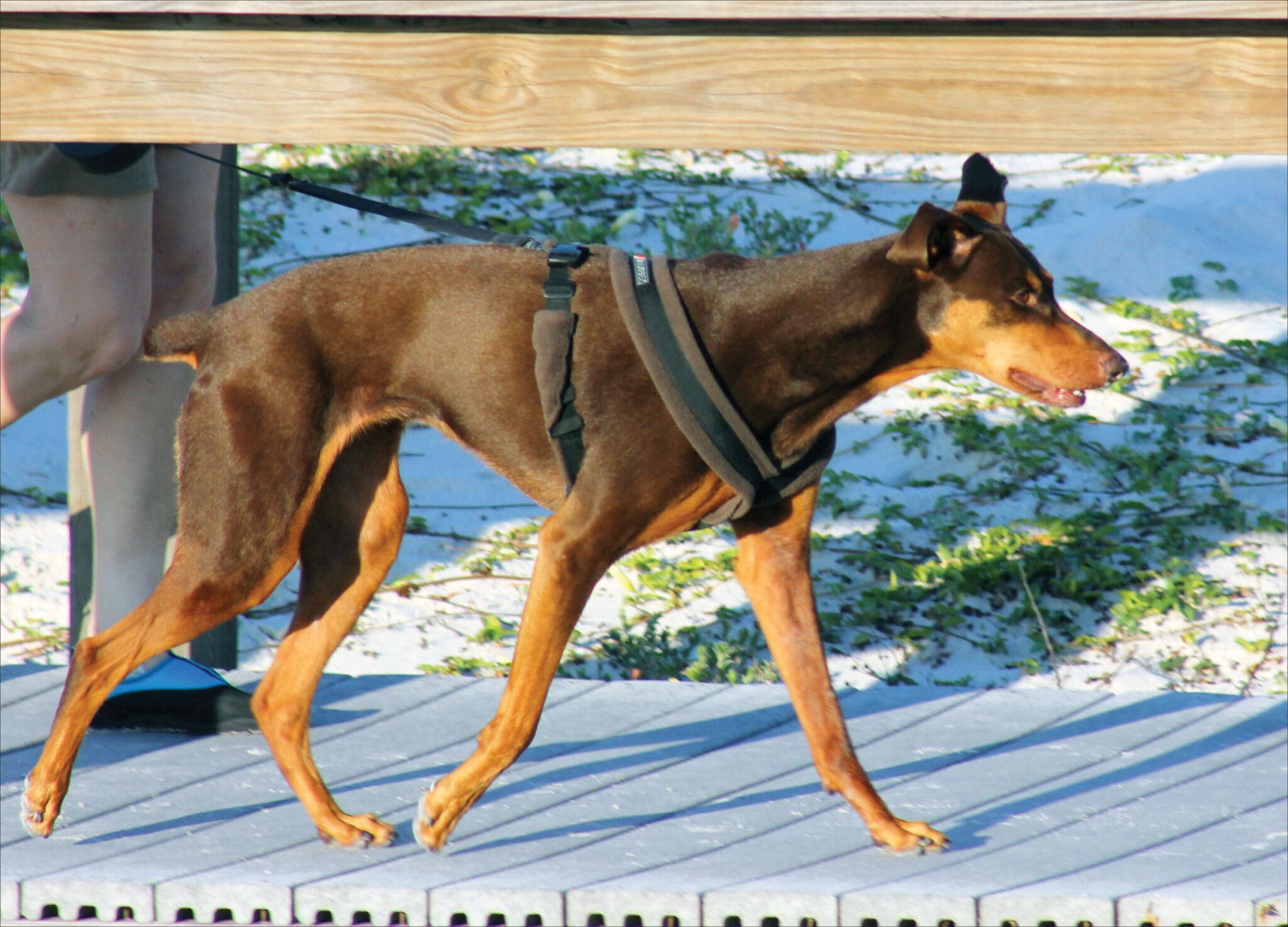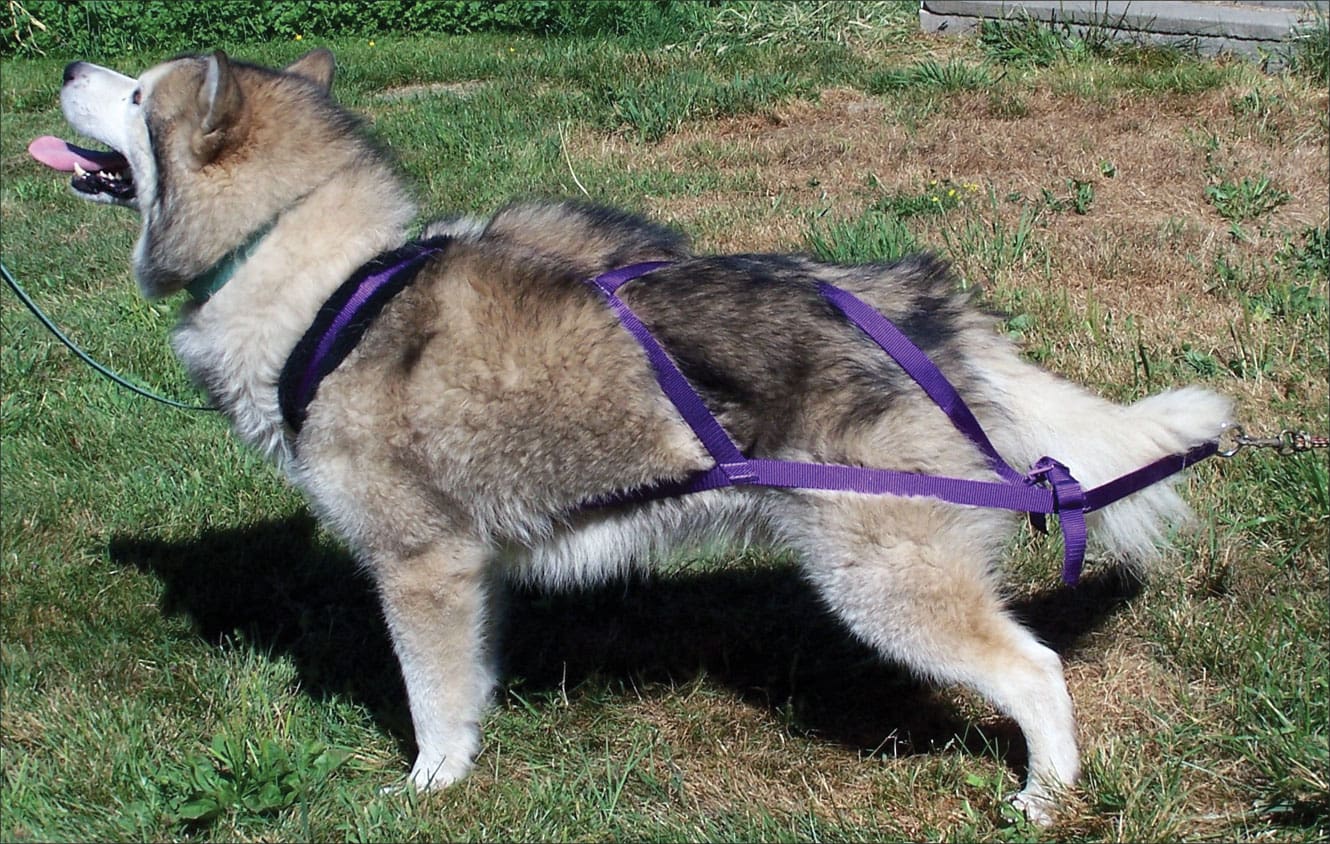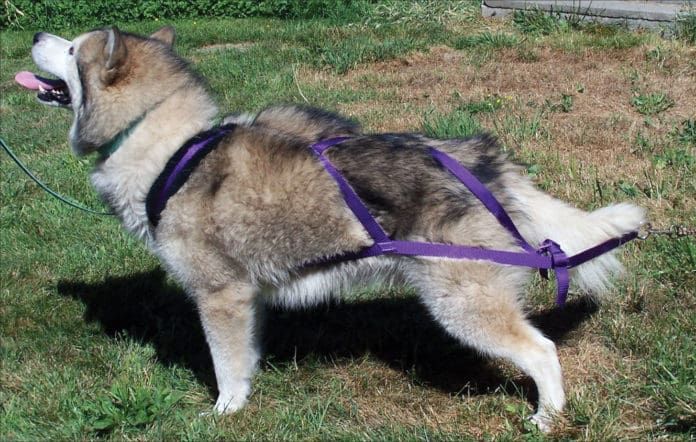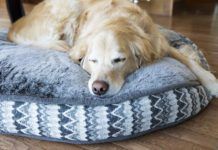Harnesses for our canine companions come in a wide variety of colors, shapes, and sizes. But did you know that many are made for a particular purpose? Have a dog you want to pull you on your skis? Got it. Have a puller – and you’d like a respite? Covered. Have a little dog? The possibilities are endless. Despite that fact, many of us walk into our local big box pet store and pull a harness off the rack without even considering the harness’ fit and function. With just a little more awareness, you can be sure that the harness you select for your dog is the right one.

Photo by David Waehner
288
Harnesses were originally created for the purpose of pulling – i.e., sleds, carts, freight, tracking, etc. Despite the fact that some harnesses can actually encourage a dog to pull due to the harness’ design and good old opposition reflex, a harness is a piece of equipment many of us, today, have in our dog equipment toolbox. Harnesses can be used for:
– An alternative to a collar
– To facilitate pulling activities
– Canine sports
– Little dogs (who might need to be picked up quickly)
– Assisting a dog with mobility
– Automobile restraint systems
– Working (service, police, etc.)
While some harnesses can cross over or serve more than one purpose, most should be considered single purpose. For example, you wouldn’t attach a dog seat belt to a front clip/no pull harness. The following are a few broad categories into which many harnesses fall, although the list is not exhaustive.
Traditional Harnesses
If you’re looking for an alternative to a collar due to your dog’s anatomy, medical condition, or you just don’t like the idea of a collar on your dog’s neck, your best bet is a simple harness that has the leash attachment on the back of the harness. Typically these harnesses have the following connected pieces: a neck piece that fits around the dog’s neck, almost like a collar; a piece that runs under the dog’s chest (in some models this is mesh, fabric, or lightly padded); and a piece around the belly. This type of harness is a good choice if your dog walks nicely on leash or you are committed to teaching him to do so, or if your dog is small.
For an everyday harness, comfort and proper fit are important. Look for a harness that doesn’t restrict the dog’s movement in any way – including his front legs and shoulders – and that has padding if/where needed. The material and stitching should be durable enough for daily use. Straps and clips should not dig into or chafe the dog’s skin.
How does the harness go on? Does your dog have to step into it? Is she physically able and willing to do so? Or does it slip over her head? Also, pay attention to the security of its fit; dogs who are really determined or creative can quickly learn to back out of some harnesses. For example, sled dogs use a neck line that attaches from their collar to the centerline of their pulling harnesses to prevent this, while other types of harnesses come with a girth strap (strap around the belly).
According to Christine Zink, DVM, PhD, DACVP, DACVSMR, a well-fitted, traditional style harness that allows free limb movement “…transfers the point of stress to the dog’s sternum, which then transfers pressure throughout the sternum, ribs, and to the vertebrae, all of which makes a very solid structure to support the dog’s weight if it does pull, while still allowing the dog’s front legs to move freely.”
Some examples of good traditional harnesses include the Sure-Fit, Walkeez, and Urban Trails. While pet supply chain stores might have what you need, generally, you can find a better selection from independent pet supply stores and online specialty retailers.
Best for:
– Walking and running on leash, particularly if your dog doesn’t pull
– Some dog sports (i.e., tracking, nose work)
– Dogs whose anatomy or a medical condition mandate the use of a harness
– Collar alternative
– Small dogs
Should NOT be used for:
– Dogs who pull on leash (if your goal is that the dog not pull)
– Pulling tasks
Note: If you use a harness in lieu of a collar, be sure you have an ID tag attached. Tags that lay flat, such as the Adjustable Collar Tag by Boomerang, work well on harnesses.
Pulling Harnesses
Harnesses that are designed for the job of pulling need to fit perfectly, be comfortable for the dog, and include padding, particularly in the neck area. Care must be taken that undue pressure is not put on sensitive parts of the dog’s body that could chafe over time, nor in areas that would restrict her movement. Material considerations are important, depending on the activity and whether the harness will get wet frequently.

Photo courtesy Nordkyn Outfitters
288
Pulling harnesses come in two basic styles: those with a fitted neck (siwash) and those with a breast band. Nordkyn Outfitters specializes in pulling harnesses, including custom gear; all of its harnesses have fitted necks. According to company owner Jane Riffle, who has been making harnesses since 1983, “The breast band harnesses (straps running horizontally across the chest) are easier to fit but are quite restrictive since they usually cross about the point of the dog’s shoulder.”
(Continued on Page 2)
Nordkyn’s website notes that getting the correct size of harness is critical, as is neck design and padding. The neck should fit snugly around the dog’s shoulders, distributing the weight evenly. If it’s too large, the harness will slip, rub, or interfere with movement; too small, and it will cut, bruise, or choke. Padding keeps webbing from cutting or chafing the dog, and provides some cushion to prevent bruising.
Riffle adds that the weight of the load the dog is expected to pull, and at what speed and distance, are equally important factors in pulling harness selection. Across the board, though, “the harness should allow the dog to lower his head, throw his shoulders into the harness, and drive with his rear.” While some models might have a clip on the back of the harness, most have side clips to which the load is attached via traces. Harnesses for pulling are best sourced from a company that specializes in this type of equipment.
Best for:
– Sports involving the pulling of weight such as mushing, skijoring, carting, and freight pull
– Activities such as nose work and tracking (certain models)
Should NOT be used for:
– Walking, particularly for dogs who pull on leash
– Other sports that don’t require the dog to pull in some fashion
– As a collar alternative
– no-pull harnesses
As the name implies, no-pull harnesses are designed to reduce the dog’s ability to pull on-leash. In many models, the leash attachment clips to the front of the harness (dog’s chest area), while others use a back clip. Some designs accomplish a cessation of pulling by causing discomfort or pain to the dog, while others (such as the Easy Walk) do so by giving a mechanical/leverage advantage to the owner. We prefer the latter type.
Additional features on some models (such as the Halti Dog Harness) include rings on both the chest and back sections. This allows the handler to clip the leash onto the back to use the harness in a more traditional style (although the harness strap still crosses the dog’s chest and is therefore restrictive), or to use a double clip leash on the front and back of the harness simultaneously.
It’s critical to carefully size and fit no-pull harnesses. We see great benefit in using no-pull harnesses while teaching dogs how to walk politely on-leash, but encourage owners to set a goal of weaning their dogs off no-pull harnesses. Because all of these harnesses restrict the dog’s movement in some way, it is imperative that they be removed for vigorous exercise (such as jogging or while at the dog park). Consider getting assistance from a qualified positive dog trainer regarding selection, fitting, and proper usage.
Best for:
– Training your dog not to pull
– Handlers who require extra control (small handler with a large dog, children, seniors, etc.)
Should NOT be used for:
– Restraining a dog in a vehicle
– Use during play
– Running or vigorous exercise
– Pulling tasks
– K9 sports/activities
Assistive harnesses
These harnesses, like pulling harnesses, are meant to do a job, so proper fit and comfort are key considerations. An assistive harness should not impede the dog’s movement in any way. Typically meant for lifting the dog (by a person), the harness should have a wide coverage area for doing so, to avoid putting undue pressure on a small area of the dog’s body. Handles should be firmly attached and appropriately placed and padded so as to allow the handler to safely assist the dog.

Photo by David Waehner
288
For dogs with mobility issues, the harness and its clips should be well padded. RuffWear’s Web Master and Doubleback harnesses can do double duty as harnesses for active dogs and small dogs, as well as for dogs who are mobility impaired, while the Help ’Em Up harness is an example of a two-handled harness designed for dogs requiring physical assistance.
Note: Just because a harness has a handle, as some sport harnesses do, does not mean that it is appropriate for lifting. If your dog has serious mobility issues, we recommend that you seek the assistance of a rehabilitation veterinarian or a professional certified in canine rehabilitation to assist with the selection, measurement and fitting of a harness. (See the March and August 2011 issues of WDJ for more on assistive equipment.)
Best for:
– Dogs with mobility impairments
– Geriatric dogs
– Lifting dogs
– Restraining dogs in vehicles (depending on the harness model)
– Walking, running, hiking, and some K9 sports
Should NOT be used for:
– Dog-dog play
– Pulling tasks
Car Restraint Harnesses
Recent press about results from canine automotive restraint crashworthiness testing performed by the Center for Pet Safety showed that four harnesses tested failed (actually, one harness did not fail but the seat belt length was too long, allowing the dog “dummy” to hit the back of the front seat).
Despite the negative results, a case can still be made that it’s safer for a dog to ride restrained via a harness and dog “seat belt” than to ride free, if only to reduce the distraction that dogs can be to drivers. While standards for dog automotive restraints need to be set, it’s nonetheless important for an automotive dog restraint harness to be well padded, particularly in the chest area; comfortable; and to have a proper fit. Measure and choose wisely.

Photo courtesy Nordkyn Outfitters
288
Best for:
– Restraining dog in a vehicle
Should NOT be used for:
– Pulling tasks
– Dog sports
– Every day use
Purpose-driven design
Whatever the purpose for which you’ll be using a harness, it’s important to consider fit, function, comfort, and durability. Follow the manufacturer’s instructions for sizing and fitting the harness and select a harness that’s appropriate for your dog’s activity. Whatever you do, don’t choose a harness only because the hot pink paisley print matches your favorite shorts!
Lisa Rodier is a freelance writer from Georgia, who shares her home with her husband and a young male Bouvier des Flandres.






